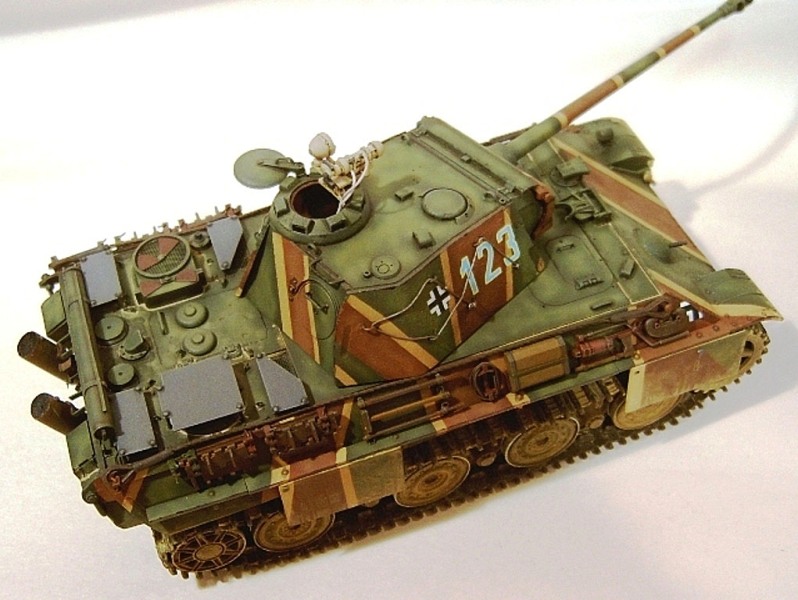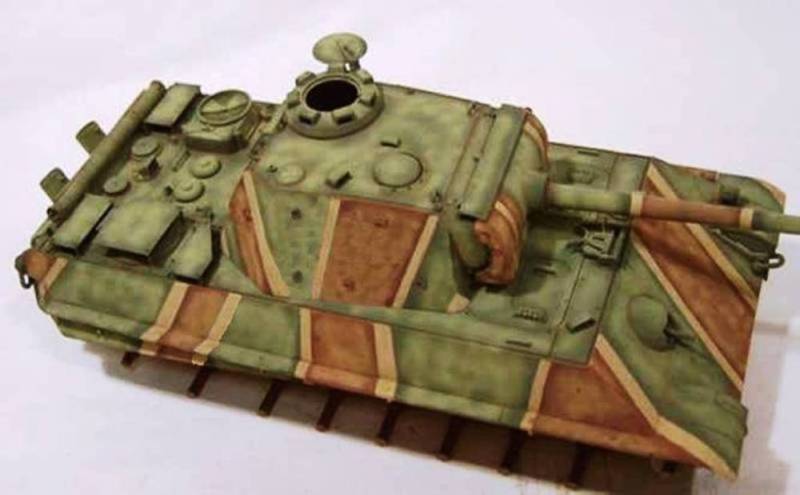I found this forum
http://www.panther1944.de/community/viewtopic.phpf=45&t=1514&start=10
Which contains several pictures of a group of late war panthers fighting in eastern Germany in February of 45. All the vehicles have a hard edged scheme of diagonal lines. Does anyone know what this camo would have looked like on top? I have seen several models featuring similar schemes which simply leave the roof blank but have been unable to find evidence to support this.
Also, does anyone have a guess as to the base color? It looks to me like either dark green or maybe primer red. Any thoughts?
Thanks in advance
Sam
Hosted by Darren Baker
late war panther camo
sdharris

Joined: February 20, 2010
KitMaker: 31 posts
Armorama: 10 posts

Posted: Wednesday, February 24, 2010 - 04:23 PM UTC

Graywolfgang

Joined: November 28, 2006
KitMaker: 303 posts
Armorama: 251 posts

Posted: Wednesday, February 24, 2010 - 05:12 PM UTC
What is the sense to camouflage the sides and not the top? The purpose of camouflage is to hide. If you only camouflaged the sides and not the sides you would stick out like a sour thumb. The reason there are no pictures of tops, the person taking only took side pictures. And mostly only one side. They weren’t worried about latter use buy modelers.
By 45 the Germans started using Red Oxide as a base color.
By 45 the Germans started using Red Oxide as a base color.
vanhall

Joined: January 23, 2007
KitMaker: 406 posts
Armorama: 391 posts

Posted: Thursday, February 25, 2010 - 11:48 AM UTC
Hi Sam,
Unfortunately your link doesn't go anywhere.. but I know the camo you mean.
I have a couple of photos of late G's with this diagonal stripe camo, where the upper surfaces can be seen... and there's no camo on the turret roof or the hull deck.
The base colour looks to be Olive Green to me... but who's knows for sure .
.
Unfortunately your link doesn't go anywhere.. but I know the camo you mean.
I have a couple of photos of late G's with this diagonal stripe camo, where the upper surfaces can be seen... and there's no camo on the turret roof or the hull deck.
The base colour looks to be Olive Green to me... but who's knows for sure
 .
.
DioRandy

Joined: October 04, 2007
KitMaker: 108 posts
Armorama: 84 posts

Posted: Thursday, February 25, 2010 - 12:52 PM UTC
Hey, Sam
I used Tamiya's acrylic Black Green XF-27 for the base coat and spots of Desert Yellow XF-59 for the camo. I pretty much followed the build feature in Verlinden's "Military Vehicles Vol. 1." However, the feature indicated the use of Humbrel's Matt Tank Gray 67 for the base coat.
The featured model showed camo spots on the turret roof and upper hull. The turret numerals were stenciled in red with a white outline. Nonetheless, I chose to wrap the turret in spare tracks. Hope this info helps.

I used Tamiya's acrylic Black Green XF-27 for the base coat and spots of Desert Yellow XF-59 for the camo. I pretty much followed the build feature in Verlinden's "Military Vehicles Vol. 1." However, the feature indicated the use of Humbrel's Matt Tank Gray 67 for the base coat.
The featured model showed camo spots on the turret roof and upper hull. The turret numerals were stenciled in red with a white outline. Nonetheless, I chose to wrap the turret in spare tracks. Hope this info helps.

footsie

Joined: May 13, 2007
KitMaker: 305 posts
Armorama: 168 posts

Posted: Thursday, February 25, 2010 - 01:19 PM UTC
i had the same problem finding a pic of the roof so i left mine plain green.

sdharris

Joined: February 20, 2010
KitMaker: 31 posts
Armorama: 10 posts

Posted: Thursday, February 25, 2010 - 01:59 PM UTC
hmmm, i guess i'll just have to take some artistic licence on this one
nice job on the models by the way.
thanks
Sam
nice job on the models by the way.
thanks
Sam
Posted: Thursday, February 25, 2010 - 07:26 PM UTC
Hi Sam
You should go for the green basecoat. I'm pretty sure that primer, rotoxide, was NOT used as basecolor. (sorry Fred!) I've read somehere, that the Panthers actually haven't been painted in rotoxide, but in a grey "zinkoxide", so if you want to let some of the basecolor shine through, it should be grey.
Jacob
You should go for the green basecoat. I'm pretty sure that primer, rotoxide, was NOT used as basecolor. (sorry Fred!) I've read somehere, that the Panthers actually haven't been painted in rotoxide, but in a grey "zinkoxide", so if you want to let some of the basecolor shine through, it should be grey.
Jacob

kaysersose

Joined: May 05, 2009
KitMaker: 86 posts
Armorama: 83 posts

Posted: Thursday, February 25, 2010 - 07:51 PM UTC
and then, my two bits...
...so implemented late in the war (March-ish 45, to be exact) was a protocol calling for an olivgrun base coat with hard edged dunkelgelb over, in a disruptive pattern; somewhere I got the idea it was in great angled areas.
Perhaps it's this very-late-war dark yellow-over-olive green scheme?
...so implemented late in the war (March-ish 45, to be exact) was a protocol calling for an olivgrun base coat with hard edged dunkelgelb over, in a disruptive pattern; somewhere I got the idea it was in great angled areas.
Perhaps it's this very-late-war dark yellow-over-olive green scheme?


GeraldOwens

Joined: March 30, 2006
KitMaker: 3,736 posts
Armorama: 3,697 posts

Posted: Thursday, February 25, 2010 - 08:12 PM UTC
Quoted Text
What is the sense to camouflage the sides and not the top? The purpose of camouflage is to hide. If you only camouflaged the sides and not the sides you would stick out like a sour thumb. The reason there are no pictures of tops, the person taking only took side pictures. And mostly only one side. They weren’t worried about latter use buy modelers.
By 45 the Germans started using Red Oxide as a base color.
According to Thomas Jentz, red primer as a base coat only appeared from September, 1944 until it was superseded by a new camouflage directive in December, 1944, calling for all parts to be base coated in Olivgrun prior to delivery to the assembly plants, where the disruptive camouflage was applied (some modern enthusiasts insist that the red primer was always overcoated with the three camouflage colors during this period, and that the directive simply meant that it was not necessary to cover the entire vehicle with a single Dunkelgelb color coat first). And, based on photographic evidence, at least one Panther armor plant produced parts coated with gray zinc phosphate primer rather than red oxide. As for camouflage on the upper decks, it would seem logical to paint disruptive patterns there as well, given the threat of Allied air attack.
The Axis discussion group on Missing-Lynx has numerous threads on this topic, if you search.
KAYELL

Joined: February 16, 2008
KitMaker: 107 posts
Armorama: 81 posts

Posted: Thursday, February 25, 2010 - 08:22 PM UTC
Tony,
Cool Camo!
Cool Camo!
Delta-Papa

Joined: October 27, 2009
KitMaker: 69 posts
Armorama: 44 posts

Posted: Thursday, February 25, 2010 - 09:14 PM UTC
I'm no boffin on cammo schemes but surely the idea is to break the silhouette of the vehicle. So logic dictates that the pattern would have to "flow" over the vehicle... not extending it over the top would emphasize the edges & make it easier to spot, especially if the observer was ah a higher elevation...
Just my 2c
Just my 2c

Posted: Thursday, February 25, 2010 - 11:54 PM UTC
At the risk of speaking well beyond the limits of my knowledge, I'd have thought the hard striped scheme in the model pic was meant to function similar to the black & white dazzle camo seen on navy ships. It assumed the target could already be seen, and attempted to break up the detail to throw off a gunner's aim (just like the British caunter scheme in the desert). That's a fundamental shift away from the "hide against the background" philosophy of three-tone soft edged schemes. In this case the roof/deck did not matter, as they wouldn't be seen by an AT gunner. Instead, the upper surfaces needed to blend in with the terrain as viewed from the sky so planes couldn't spot them. That makes it more likely they were left Olivgrun with a coating of dust.
Did the crews use them as delivered, or did they cover them with branches like tanks seen in Normandy? I could see the camo pundits (safely away from the Front) suggesting a visible disruptive philosophy, but the guys at the sharp end "over-ruling" it by turning their tanks into rolling shrubs in an effort not to be seen at all...
Tom
Did the crews use them as delivered, or did they cover them with branches like tanks seen in Normandy? I could see the camo pundits (safely away from the Front) suggesting a visible disruptive philosophy, but the guys at the sharp end "over-ruling" it by turning their tanks into rolling shrubs in an effort not to be seen at all...
Tom

Headhunter506

Joined: December 01, 2007
KitMaker: 1,575 posts
Armorama: 1,509 posts

Posted: Friday, February 26, 2010 - 05:10 AM UTC
Quoted Text
According to Thomas Jentz, red primer as a base coat only appeared from September, 1944 until it was superseded by a new camouflage directive in December, 1944, calling for all parts to be base coated in Olivgrun prior to delivery to the assembly plants, where the disruptive camouflage was applied (some modern enthusiasts insist that the red primer was always overcoated with the three camouflage colors during this period, and that the directive simply meant that it was not necessary to cover the entire vehicle with a single Dunkelgelb color coat first). And, based on photographic evidence, at least one Panther armor plant produced parts coated with gray zinc phosphate primer rather than red oxide. As for camouflage on the upper decks, it would seem logical to paint disruptive patterns there as well, given the threat of Allied air attack.
The Axis discussion group on Missing-Lynx has numerous threads on this topic, if you search.
Here's a link to one of those discussions:
http://www.network54.com/Forum/47207/thread/1264544311/Hetzer%27s+primer
This link explains zinc coatings and their applications:
http://www.zincinfocentre.org/zinc_applications.html
Pay attention to this:
Quoted Text
Automatic grit blasting and zinc dust paint spraying equipment are widely used in steel workshops and shipyards to protect steel plates during storage before fabrication and until application of the final coating system.
That's what the German manufacturers were doing to steel sheets after the sheets were made, and, prior to final construction and application of finishing coats. That included application of red primer over the already zinc-coated assemblies.
The photos of Panthers with a puported zinc finishing coat probably are pictures of vehicles still in the assembly stage of production, prior to receiving red primer. Additionally, if those are B/W images, there is no way in hell that one could identify with 100% certainty what a particular color is. Colors in B/W are represented by different levels of black. Due to the nature of orthographic film (Agfa, in particular), there are unrelated colors which would appear nearly, if not completely, identical to each other.
Removed by original poster on 02/26/10 - 17:42:32 (GMT).
sdharris

Joined: February 20, 2010
KitMaker: 31 posts
Armorama: 10 posts

Posted: Friday, February 26, 2010 - 05:47 AM UTC
I've been trying to post a link to the photos but so far have been unsuccessful.
does it work now?
http://www.panther1944.de/community/viewtopic.php?f=45&t=1514&start=10
does it work now?
http://www.panther1944.de/community/viewtopic.php?f=45&t=1514&start=10
vanhall

Joined: January 23, 2007
KitMaker: 406 posts
Armorama: 391 posts

Posted: Saturday, February 27, 2010 - 03:04 AM UTC
Quoted Text
I've been trying to post a link to the photos but so far have been unsuccessful.
does it work now?
http://www.panther1944.de/community/viewtopic.php?f=45&t=1514&start=10
Yes it's working now Sam.
Here's a (not very good) copy of a photo from the book "May 1945 in the Czech lands".
But you can see the camo 'stripes' do not continue over the hull or turret roofs:

A Japanese magazine interpretation:

..and mine:



PantherF

Joined: June 10, 2005
KitMaker: 6,188 posts
Armorama: 5,960 posts

Posted: Saturday, February 27, 2010 - 04:23 AM UTC
footsie, vanhall ... what is the shade of green you gentlemen used on your Panther? I am driving myself crazy with all the various shades of green used by different manufacturers.
Like Tamiya suggests the spray TS-2 which is Dark Green and they also list it as Dunkelgrun. Is that correct?
Thanks for any input.
Like Tamiya suggests the spray TS-2 which is Dark Green and they also list it as Dunkelgrun. Is that correct?
Thanks for any input.
vanhall

Joined: January 23, 2007
KitMaker: 406 posts
Armorama: 391 posts

Posted: Saturday, February 27, 2010 - 05:40 AM UTC
Hi Jeff,
I use Lifecolor UA206 " RAL 6003 Olivgrün".
Here's how it looks before the camo, weathering etc.

I use Lifecolor UA206 " RAL 6003 Olivgrün".
Here's how it looks before the camo, weathering etc.

mmeier

Joined: October 22, 2008
KitMaker: 1,280 posts
Armorama: 1,015 posts

Posted: Saturday, February 27, 2010 - 08:33 AM UTC
For what it is worth:
The common anti-rust primer used on almost anything metal in germany well into the early 1980s was commonly known as "Menninge" and is a rather bright red, lead-based paint. Any vehicle will likely have an undercoat of those.
The color is not very scratch-resistant so it will almost always get an overcoat if used on any part that will see wear including movement surfaces. And it's a tad toxic so covering is a must for everything you come in contact with.
The common anti-rust primer used on almost anything metal in germany well into the early 1980s was commonly known as "Menninge" and is a rather bright red, lead-based paint. Any vehicle will likely have an undercoat of those.
The color is not very scratch-resistant so it will almost always get an overcoat if used on any part that will see wear including movement surfaces. And it's a tad toxic so covering is a must for everything you come in contact with.
footsie

Joined: May 13, 2007
KitMaker: 305 posts
Armorama: 168 posts

Posted: Saturday, February 27, 2010 - 11:48 AM UTC
i used tamiya NATO green as a base color with varying amounts of yellow green to fade things out a bit, heres a pic with the base colors applied.

cheers tony.

cheers tony.
Fledermaus

Joined: January 05, 2007
KitMaker: 236 posts
Armorama: 174 posts

Posted: Saturday, February 27, 2010 - 12:30 PM UTC
Van,
Excellent job on your panther.
How did you mask the paint job?
Can you please post some more photos?
Thanks.
Matt
Excellent job on your panther.
How did you mask the paint job?
Can you please post some more photos?
Thanks.
Matt


PantherF

Joined: June 10, 2005
KitMaker: 6,188 posts
Armorama: 5,960 posts

Posted: Saturday, February 27, 2010 - 02:16 PM UTC
Thanks for the replies guys, that helps a great deal! Both Panthers are awesome! 

crnfrd

Joined: May 30, 2008
KitMaker: 22 posts
Armorama: 21 posts

Posted: Saturday, February 27, 2010 - 02:20 PM UTC
Those Panthers are from Pz. Abt. 25, 15.Pz. Gren. Div. in the Oderbrueck near Kuestrin in very early 2/45. The images are grabs from a clip that I think you can find on Youtube. The diagonal striped camo was used by MNH for the entire factory-camo period. No, it didn't extend to upper surfaces (compare the hardedge pattern used by MAN and DB, which did, as far as I can tell.) As the color profile at your link shows, the stripes divide apparent dunkelgruen RAL 6003 areas from areas of rotbraun RAL 8017. The photo from the Jakl book posted above to show the plain upper surfaces (PR27/19.PD [?] in Czechy) doesn't show the brown-green difference nearly as clearly, but that may well be because that photo was taken with western panchromatic film instead of German orthochromatic film, which makes anything with red values very dark. Green is the base color.
vanhall

Joined: January 23, 2007
KitMaker: 406 posts
Armorama: 391 posts

Posted: Saturday, February 27, 2010 - 03:54 PM UTC
Quoted Text
Van,
Excellent job on your panther.
How did you mask the paint job?
Can you please post some more photos?
Thanks.
Matt
Thanks Matt.
I simply masked off with tape. The brown first and later the yellow.
The tricky places, the hull sides mainly where I couldn't get in with the tape, I hand painted with very thin paint.
A few more pics:








Fledermaus

Joined: January 05, 2007
KitMaker: 236 posts
Armorama: 174 posts

Posted: Saturday, February 27, 2010 - 04:35 PM UTC
Thanks Van!
Great job overall!
It's interesting how the camo patteran wasn't carried onto the lower bow plate.
I have the Tamiya late Panther G late version kit #35176.
Would that kit be suitable for that camo pattern?
Thanks again.
Matt
Great job overall!
It's interesting how the camo patteran wasn't carried onto the lower bow plate.
I have the Tamiya late Panther G late version kit #35176.
Would that kit be suitable for that camo pattern?
Thanks again.
Matt
 |













